The Canon 65mm MP-E is the only macro lens currently in production that is able to reach 5:1 without extension tubes or any other accessory. Five to one! This is a pretty crazy magnification, and if you add an APS-C camera body, you get so much magnification that you can fill the frame with the eye of a fly! I already used this lens in the past - and I loved it - but now I have decided to do an in depth review with MP-E on 7D.
Many thanks to my friend
Sandro who loaned me this lens!
As usual, I recommend to give a look to the page
Testing and reviewing a lens: it will help you to understand better this review and my testing methodology!
Specifications (compared the Canon 180 Macro)
����| � | � �Canon 65mm f/2.8 MP-E | � �Canon 180mm f/3.5 Macro L USM |
�
| �Focal length | � �65 mm | � �180 mm |
�
| �Macro ratio | � �from 1x to 5x (5:1) | � �1x (1:1) |
�
| �Max Aperture | � �f/2.8 | � �f/3.5 |
�
| �Stabilization | � �No | � �No |
�
| �Autofocus | � �not available (MF only) | � �Ultrasonic AF Motor |
�
| �Minima distanza di fuoco | � �0.24 meters | � �0.48 meters |
�
| �Dimensions | � �81 (D) x 98 (L) mm | � �83 (D) x 187 (L) mm |
�
| �Weight | � �740 g | � �1090 g |
�
| �Weather sealing | � �No | � �No |
�
| �Price | � �$ 950 (+ $500 or $ 730 for flash) | � �$ 1370 |
�
| �Production | � �1999- | � �1996-� |
�
Built quality and autofocus
Even though it is not labeled as "L", the built quality is nothing short of professional - on par with the Canon 180 Macro L and other professional Canon lenses. The guy who sticks "L" badges on Canon lenses must have been at home the day Canon came out with this lens, because the MP-E is an L lens in every respect, both in terms of image quality and built quality. The MP-E is built in metal; it is not weather sealed (but even the 180 Macro L has no sealing), overall it feels very solid. At 1:1 magnification, it looks small and innocent, but when you focus to 5:1, the lens becomes huge, it get even a little longer than the big Canon 180mm Macro. This is because it incorporates a kind of extension tube, that allows to reach such impressive magnifications.
There are few Canon lenses that don't have autofocus, and the MP-E is one of these. Even though it is called 1x-5x, it is not a zoom, when you move the large rubber ring you are not zooming, you are moving the focus, to increase the magnification. Of course there is not image stabilization, but in this case is not a problem, the MP-E is not a lens you will handheld often (unless you are shooting with flash as main light).
Another peculiarity of the MP-E is that you can easily get more magnification than 1:1, but you can not get less. In other words, it is impossible to take a portrait or a landscape photo with the MP-E, because the widest area that it can frame is 24x36mm (or 16x24mm if you are using an APS-C camera). The majority of macro photographers who own this lens have also a more versatile macro as the 100mm or 180mm, that can be used even for subjects larger than 24x36mm.
In front of the lens, you can easily mount a ring flash or other kind of flashes: at the highest magnifications it is almost impossible to take a sharp photo without flash. Canon sell two flashes thought for macro work: the Canon MR-14EX TTL Macro Ring Lite Flash ($500) and the Canon MT-24EX Macro Twin Lite Flash ($ 730). When you buy the MP-E, I highly recommend to buy one of these flashes.
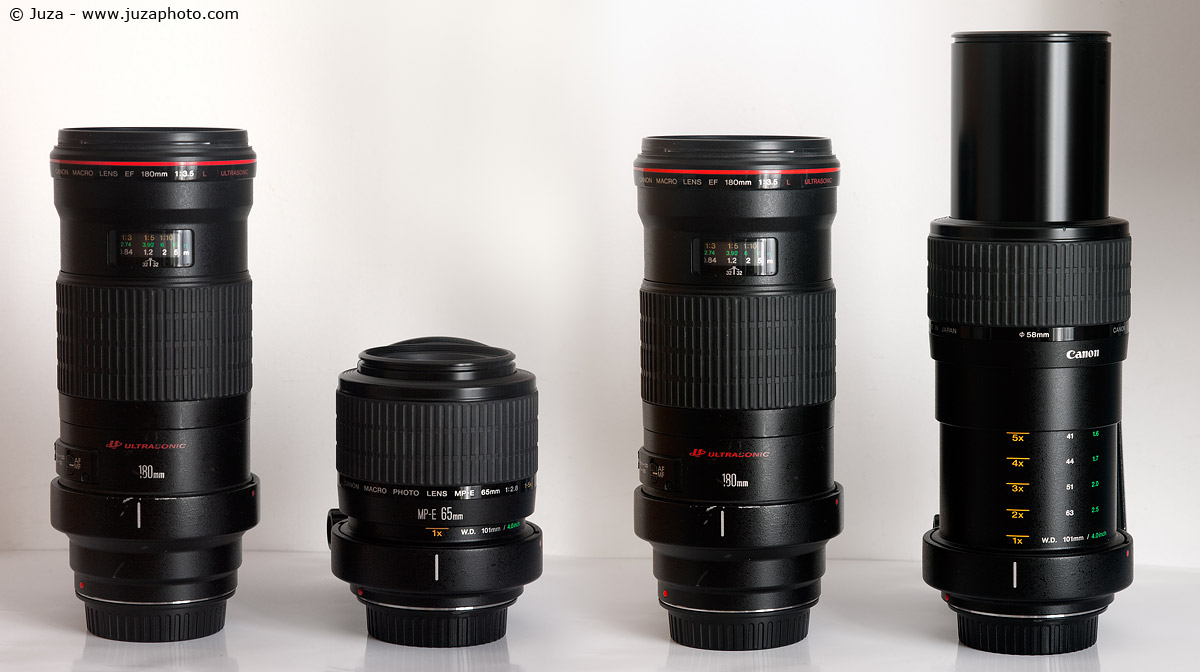
Size comparison: on the left you can see the Canon 180mm Macro L vs the Canon MP-E at 1:1, while on the right there is the Canon 180mm vs the MP-E at 5:1.
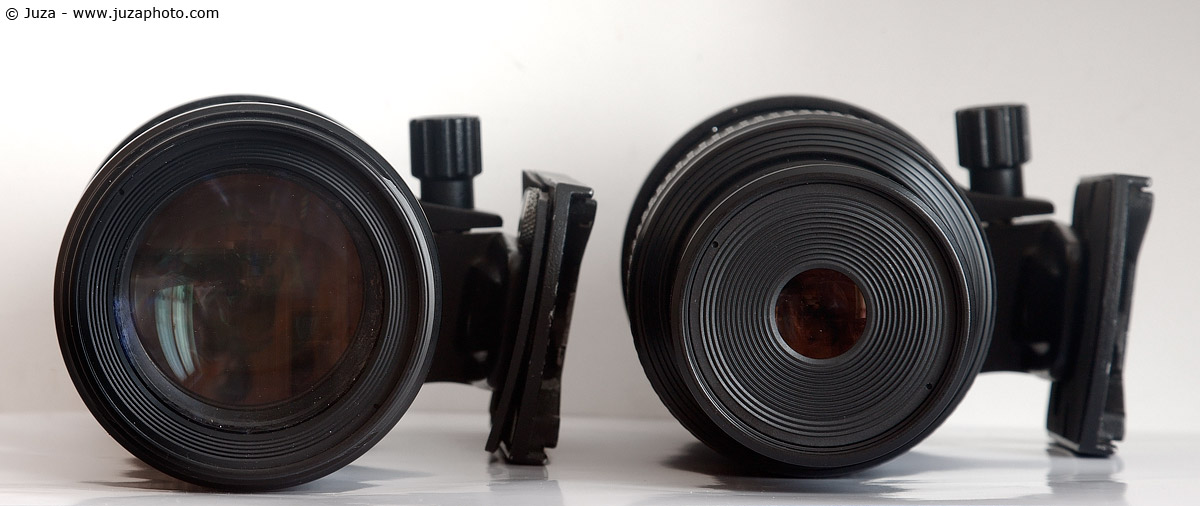
Front elements comparison: the 180mm (left) has a big front element, while the front element of the MP-E is surprisingly small.
The MP-E in the field : getting crazy with (no) depth of field
The MP-E is a quite difficult lens in the field. Forget the 24 centimeters focusing distance: it its not "true" even at 1:1, because it is the distance from the focus plane (sensor) to the subject, so the real distance from the front of the lens to the subject is about 11 centimeters. Add the ring flash, and you are at about 8-9 centimeters from the subject. At the highest magnification, the real distance is further reduced to about 2 or 3 centimeters: by this time, if the bug you are photographing has not moved yet, it may be because it has dead of terror ;-)
But the real problem is not working distance: it is the depth of field, that is almost inexistent. At the highest magnifications, you have to work at f/4 or f/5.6 to get a good sharpness (f/8 has already a very strong diffraction, and f/11 or f/16 are unusable)...as you can imagine, the depth of field is truly minimal at these apertures, so it is impossible to get everything in focus. You must do a selective focus on the most important areas of the subject, and it is not easy; otherwise you can try to take various photos and to do focus blending to extend the depth of field, but it is not easy either, and sometimes it is impossible. In some cases, the only way to get the photo is to stop down to f/8 or f/11 in spite of the diffraction; the detail will be quite soft, but the alternative is to get a photo where nearly everything is out of focus, except a 3-4% of the frame.
Working in natural light is not easy at 1:1 and 2:1, it is very difficult at 3:1 and it is almost impossible at 4:1 or 5:1, because at these magnifications every minimal vibration result in a blurred photo. Most of the times the MP-E is used with flash: the flash allows to eliminate both the blur created by your movements and the subject movements. Other than that, a tripod with gear head (as Manfrotto 410) and focus rail are a big help to focus and compose the photo: the MP-E is different from the classic lenses. With MP-E, you rotate the focus ring to choose the magnification, then you focus by moving closer or more distant to the subject.
Image quality
I have tested the lenses on my Canon 7D (18 megapixel, APS-C). The lenses were mounted on tripod; I have used mirror lock up and self timer. The following images are 100% crop from the unprocessed RAW file. Usually I include a comparison with one or more similar lenses, but since there is not any lens similar to the MP-E, here I have focused the image quality test on the quality of the MP-E at every magnification and aperture.
Magnification 1:1 crops (the test photo measured 22.3 x 14.9 mm; each 100% crop shows an area of 2.1 x 1.6 millimeters)
����| �f/2.8 | � �f/4 |
�
� | � �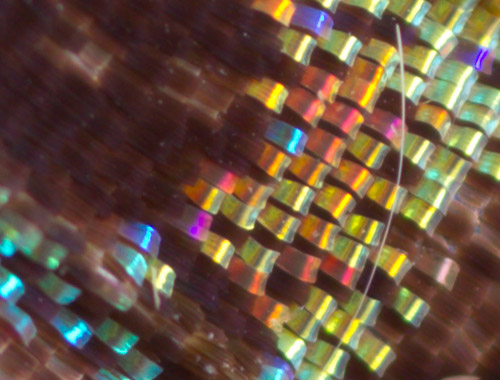 | �
�
����| �f/5.6 | � �f/8 |
�
� | � �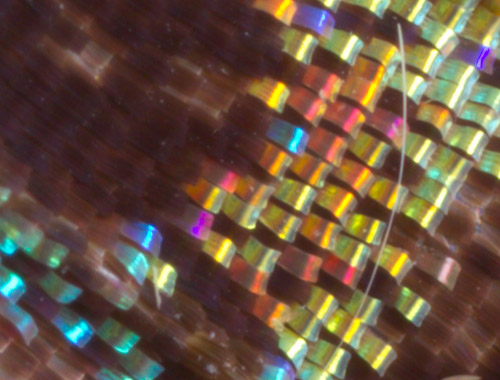 | �
�
����| �f/11 | � �f/16 |
�
�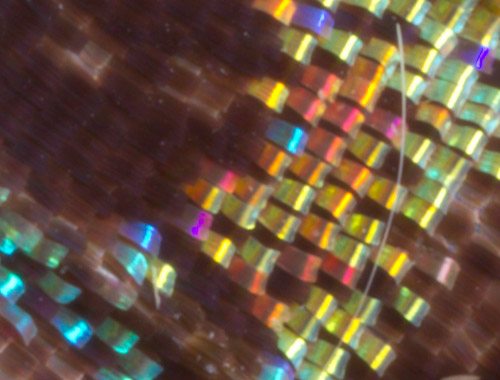 | � �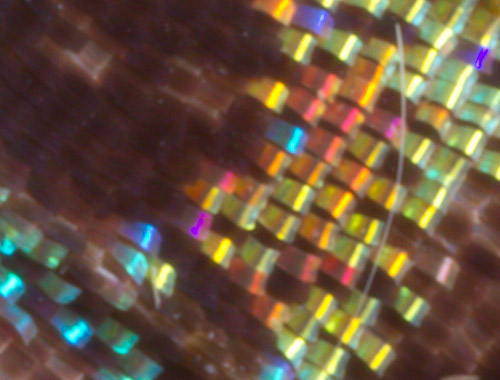 | �
�
At 1:1, the image quality is good between f/2.8 and f/8; f/11 is bit soft but still usable, while I'd try to avoid f/16.
Magnification 2:1 crops (the test photo measured 11.2 x 7.5 mm; each 100% crop shows an area of 1.05 x 0.81 millimeters)
����| �f/2.8 | � �f/4 |
�
� | � � | �
�
����| �f/5.6 | � �f/8 |
�
� | � �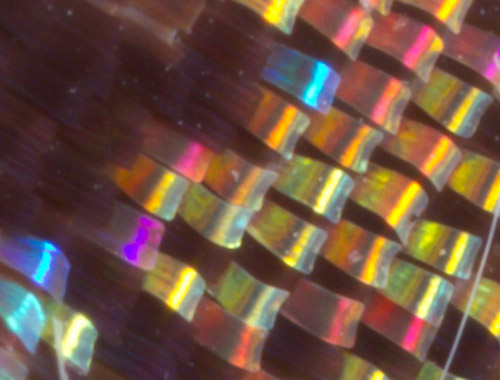 | �
�
����| �f/11 | � �f/16 |
�
� | � �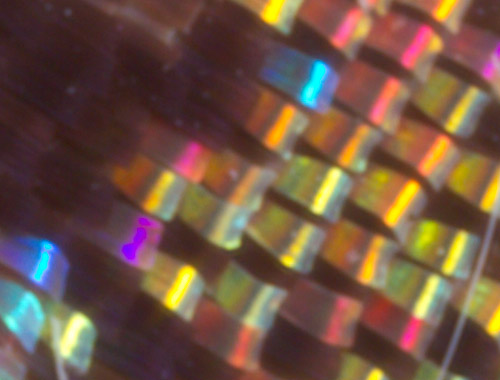 | �
�
At 2:1, the image quality is ok at f/2.8, but it clearly gets better at f/4 and f/5.6. You have good sharpness until f/8, while f/11 is a bit too soft for my standard, and f/16 is unusable.
Magnification 3:1 crops (the test photo measured 7.4 x 4.9 mm; each 100% crop shows an area of 0.70 x 0.54 millimeters)
����| �f/2.8 | � �f/4 |
�
�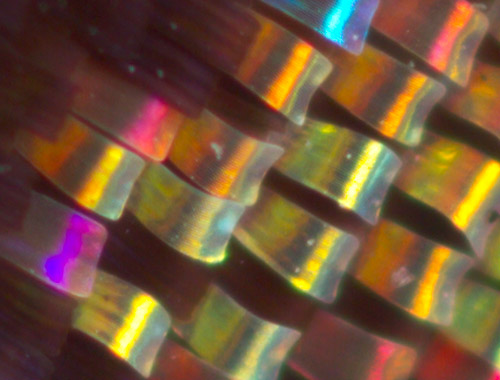 | � � | �
�
����| �f/5.6 | � �f/8 |
�
�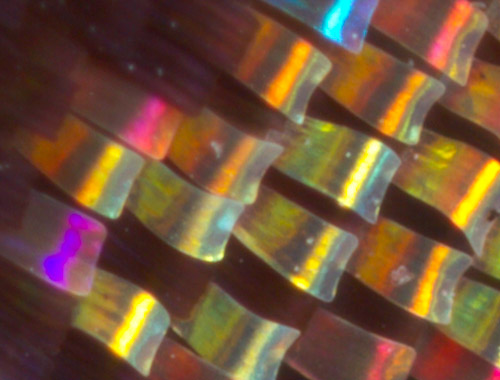 | � �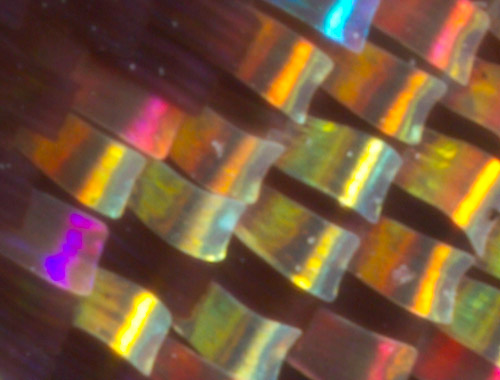 | �
�
����| �f/11 | � �f/16 |
�
�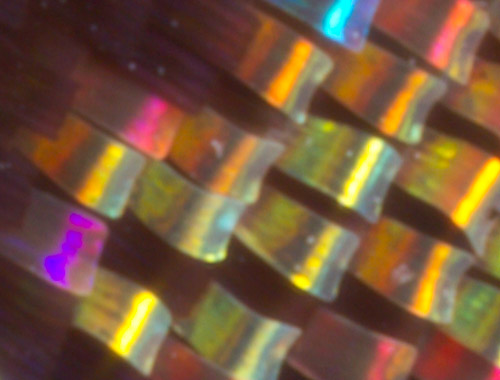 | � �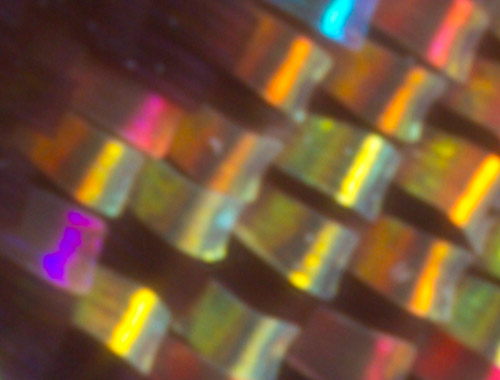 | �
�
At 3:1, you have good image quality between f/2.8 and f/5.6. I'd recommend to use f/8 only if you really need it, and I'd avoid f/11 or f/16.
Magnification 4:1 crops (the test photo measured 5.57 x 3.72 mm; each 100% crop shows an area of 0.52 x 0.40 millimeters)
����| �f/2.8 | � �f/4 |
�
�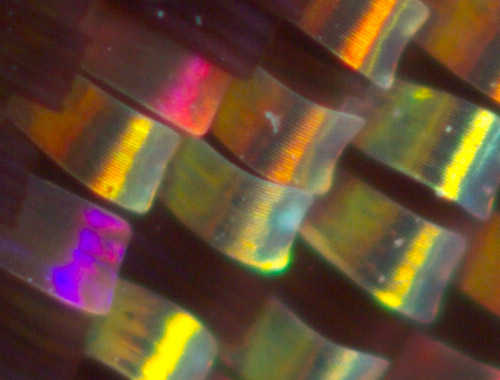 | � �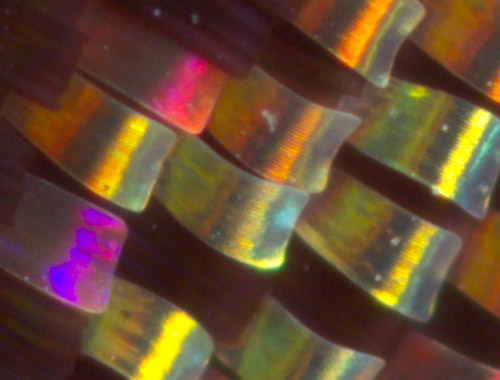 | �
�
����| �f/5.6 | � �f/8 |
�
� | � �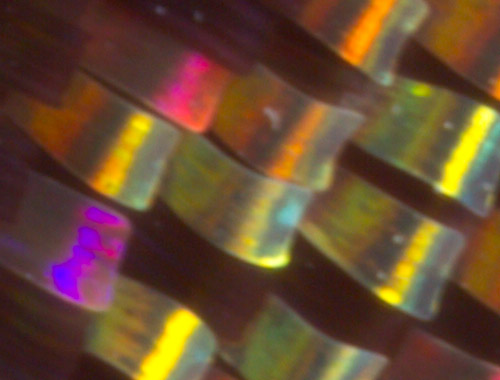 | �
�
����| �f/11 | � �f/16 |
�
�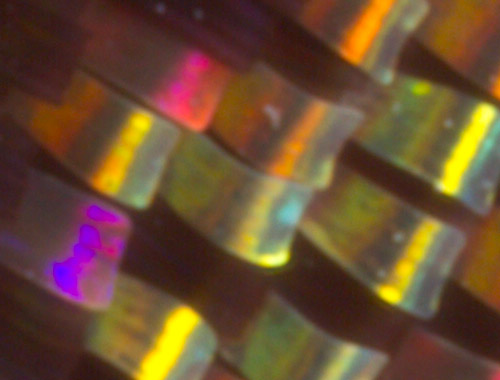 | � �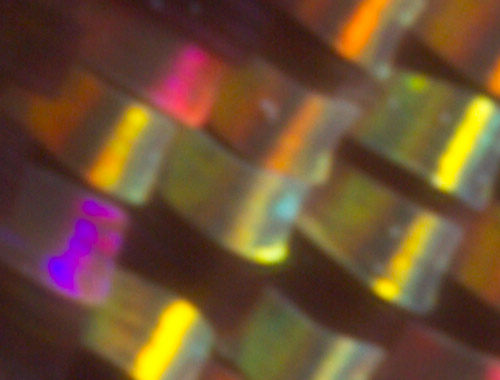 | �
�
At 4:1, image quality is good at f/2.8 and f/4; I'd recommend to use f/5.6 only is you really need it, and I'd recommend to avoid f/8, f/11 and f/16.
Magnification 5:1 crops (the test photo measured 4.46 x 2.98 mm; each 100% crop shows an area of 0.42 x 0.32 millimeters)
����| �f/2.8 | � �f/4 |
�
�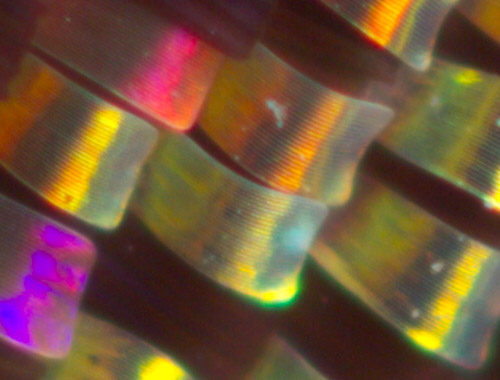 | � �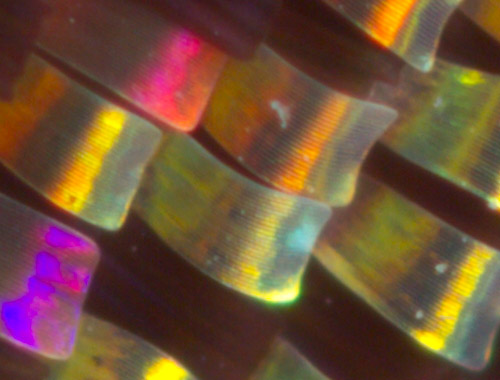 | �
�
����| �f/5.6 | � �f/8 |
�
�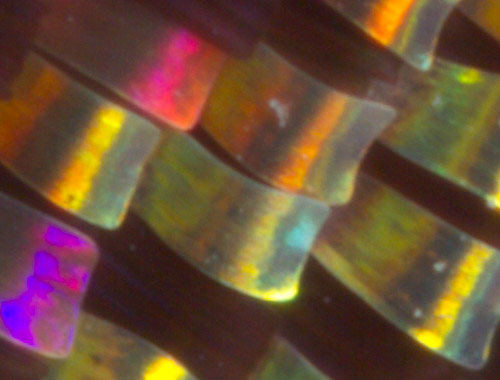 | � � | �
�
����| �f/11 | � �f/16 |
�
�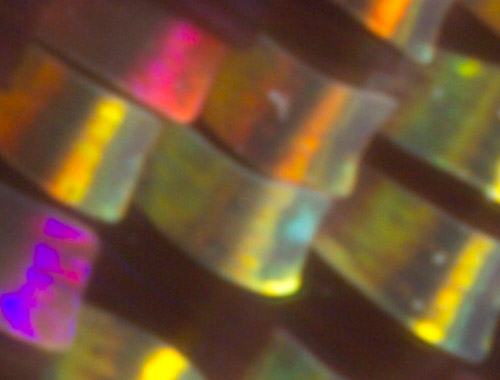 | � � | �
�
At 5:1, the maximum magnification, the image quality is good only at f/2.8 and f/4. f/5.6 is really at the limit; f/8 and smaller apertures are unusable.
This test is done with the Canon 7D, that adds 1.6x magnification to the already stellar magnification of the Canon MP-E. If you use a fullframe camera, you will get less magnification, but you will be able to stop down about 1 stop more without losing image quality. For example, the image quality of the MP-E at 5:1 and f/4 on 7D is the same IQ of the MP-E at 5:1 and f/5.6 on 1DsIII. On the other hand, with the 7D you have 1 stop more depth of field, so at the end the results are about the same.
As already said, remember that sometimes you will have to stop down beyond the "recommended aperture", otherwise the depth of field will be so thin than almost everything will be out of focus: sometimes you have to sacrifice detail for depth of field.
Samples and comments
These are some sample photos taken with the Canon 65mm f/2.8 MP-E on Canon 7D. You can download either the untouched photo (JPEG converted from RAW without any additional post processing; minimum contrast and saturation, no sharpening, no AC, distortion or vignetting correction) or the post processed version. The untouched photo is a good way to see the real image quality of the lens, and the post processed versions allow to see the final quality you can get with good post processing techniques.
�
�
The image quality is good, if you don't stop down too much. At 5:1 it is difficult to get truly razor sharp images at 100%, in particular on a APS-C camera, but overall the image quality is ok for an extreme lens like this. I'd say that it is the best 5:1 macro lens of the world and, by the way, it is also the only 5:1 macro of the world :-) All these samples had been taken at f/5.6, that is the smallest aperture you can use at the highest magnifications without strong diffraction.
Conclusions
The Canon MP-E is a great lens; there is nothing to fault. It is difficult to use, and the image quality is good only if you don't stop down too much, but these are not faults of the lens - they are the unavoidable problems of working at very high magnification. If you are an experienced macro photographer, and you want a lens to go beyond 1:1, I highly recommend the Canon MP-E! It is an awesome tool and it has a very reasonable price, even though you have to add some hundreds of dollars for the flash.
If you are looking for your first macro lens, instead, forget about it. Without a good experience with macro work, it is difficult to get good results with this lens...it is like a F1 car: if you are a pilot you can go crazy fast, but if you are used to drive a Fiat Panda, you would go straight at the first turn.

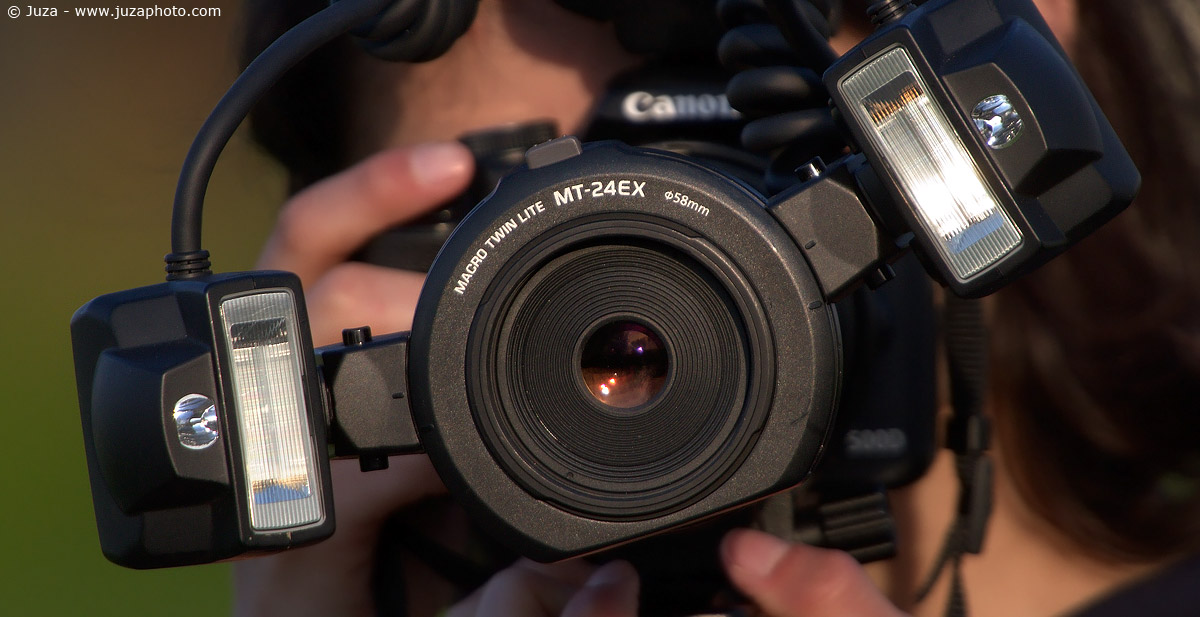
































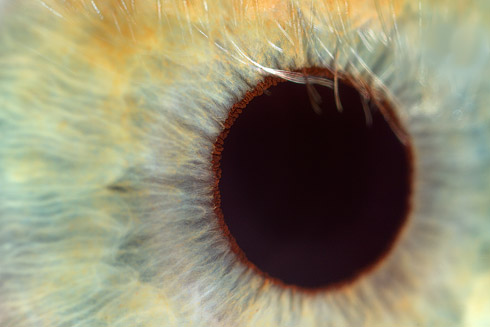
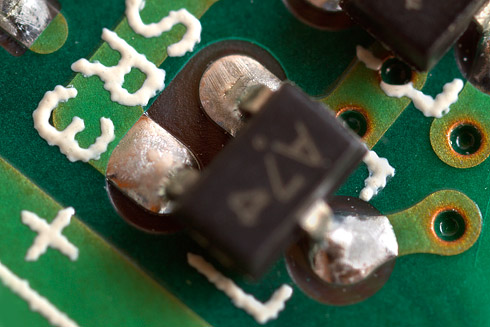
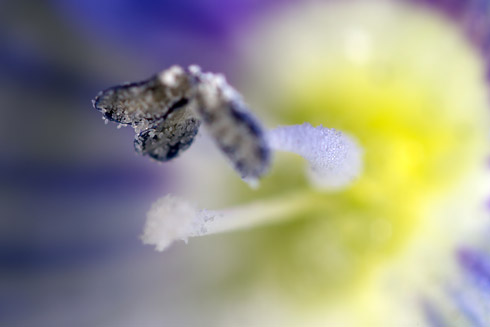
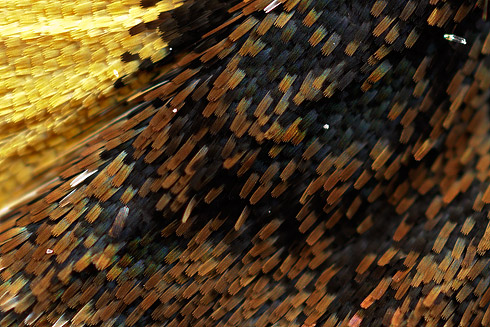
 JuzaPhoto contains affiliate links from Amazon and Ebay and JuzaPhoto earn a commission in case of purchase through affiliate links.
JuzaPhoto contains affiliate links from Amazon and Ebay and JuzaPhoto earn a commission in case of purchase through affiliate links.